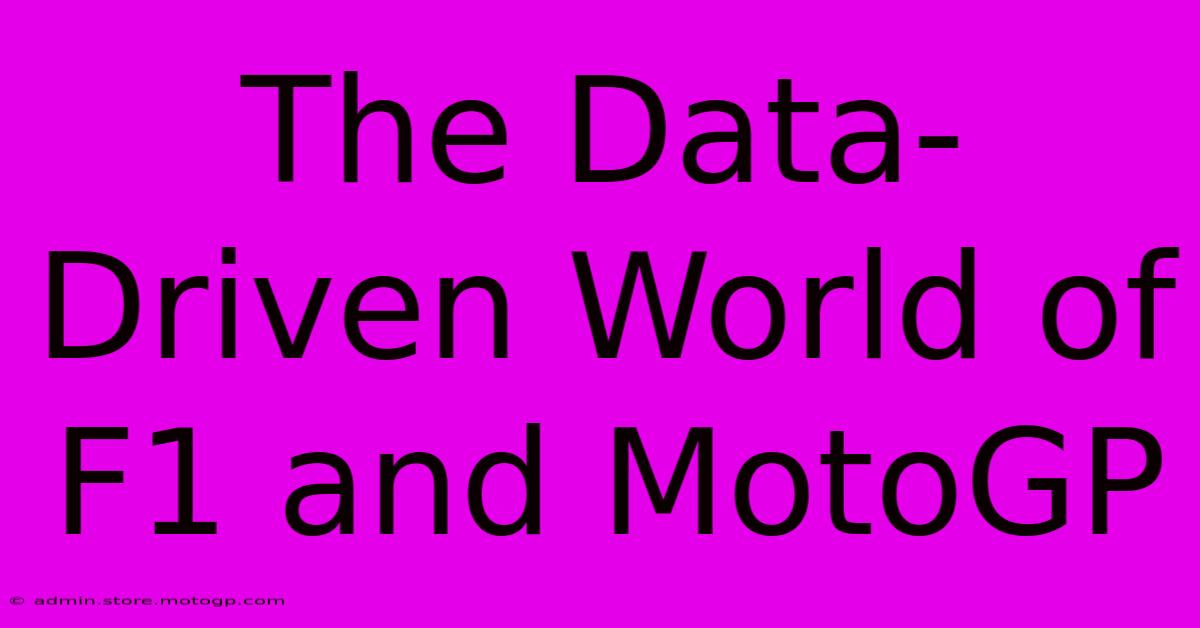The Data-Driven World Of F1 And MotoGP

Table of Contents
The Data-Driven World of F1 and MotoGP: How Numbers Fuel Success
The roar of the engines, the screech of tires, the nail-biting finishes – Formula 1 and MotoGP are spectacles of speed, skill, and adrenaline. But beneath the surface of these thrilling races lies a world of meticulous data analysis, where gigabytes of information are crunched to gain even the smallest competitive edge. This article delves into the data-driven revolution transforming both F1 and MotoGP.
The Data Deluge: Sensors and Telemetry
Modern F1 and MotoGP bikes are essentially rolling supercomputers. Hundreds of sensors embedded within the vehicles constantly collect data on various parameters, including:
- Engine performance: RPM, torque, fuel consumption, temperature.
- Aerodynamics: Air pressure, downforce, drag.
- Tire performance: Pressure, temperature, wear.
- Chassis performance: Suspension travel, braking force, steering angle.
- Rider/Driver performance: Heart rate, braking points, cornering speeds, acceleration.
This data is transmitted wirelessly to pit crews and engineers in real-time via telemetry systems. The sheer volume of information generated is staggering, requiring sophisticated data processing and analysis techniques.
Beyond the Track: Simulators and Wind Tunnels
The data collected on the track isn't the only source of information. Sophisticated simulators and wind tunnels play a crucial role in optimizing vehicle performance. Simulations allow engineers to test various configurations and settings virtually, saving time and resources. Wind tunnel testing provides crucial data on aerodynamic efficiency, allowing teams to fine-tune car and bike designs for optimal performance. This data is then integrated with track data to create a holistic understanding of vehicle behavior.
Data Analysis: Unlocking Performance Insights
The raw data collected is useless without effective analysis. Teams employ a dedicated army of engineers, data scientists, and analysts to sift through the massive datasets and extract meaningful insights. Advanced analytical techniques such as:
- Machine learning: Identifying patterns and predicting future performance.
- Statistical modeling: Quantifying the impact of various factors on performance.
- Data visualization: Presenting complex information in a clear and concise manner.
are used to understand the complex interplay of variables affecting race performance. This allows teams to make informed decisions regarding:
- Strategy: Tire choice, pit stops, fuel management.
- Setup: Car/bike adjustments to optimize handling and performance.
- Driver/Rider coaching: Identifying areas for improvement in driving/riding style.
The Human Element: Data and Driver/Rider Synergy
While data plays a crucial role, it's essential to remember that F1 and MotoGP are ultimately about human performance. The best teams are those that effectively integrate data-driven insights with the expertise and intuition of their drivers and riders. The data provides a foundation for decision-making, but the human element remains irreplaceable in translating this data into on-track success. A driver's feel for the car or a rider's intuition about the bike can often provide valuable insights that go beyond the numbers.
The Future of Data in F1 and MotoGP
The role of data in F1 and MotoGP is only going to grow in the future. As sensors become more sophisticated and data analysis techniques become more advanced, we can expect even more precise and detailed insights into vehicle and driver/rider performance. This will lead to:
- Increased competitiveness: Smaller margins of error will necessitate greater reliance on data analysis.
- Enhanced safety: Data-driven insights can help identify potential safety risks and improve track safety measures.
- More sustainable racing: Optimization of fuel consumption and tire wear will be crucial in reducing environmental impact.
In conclusion, the data-driven revolution is transforming F1 and MotoGP, ushering in an era of unprecedented precision and competitiveness. The ability to effectively collect, analyze, and interpret data will be the key to future success in these thrilling motorsports. The symbiosis between human skill and technological advancement is paving the way for an exciting future in racing.

Thank you for visiting our website wich cover about The Data-Driven World Of F1 And MotoGP. We hope the information provided has been useful to you. Feel free to contact us if you have any questions or need further assistance. See you next time and dont miss to bookmark.
Featured Posts
-
Moto Gp Sprint Race Results Who Will Claim Victory
Feb 20, 2025
-
Fast Efficient And Luxurious The F1 Shuttle
Feb 20, 2025
-
Desmosedici The Moto Gp Legend Lives On
Feb 20, 2025
-
Experience The Apex Moto Gp Bike For Sale
Feb 20, 2025
-
Moto Gp On Tnt Sports Beyond The Track
Feb 20, 2025
